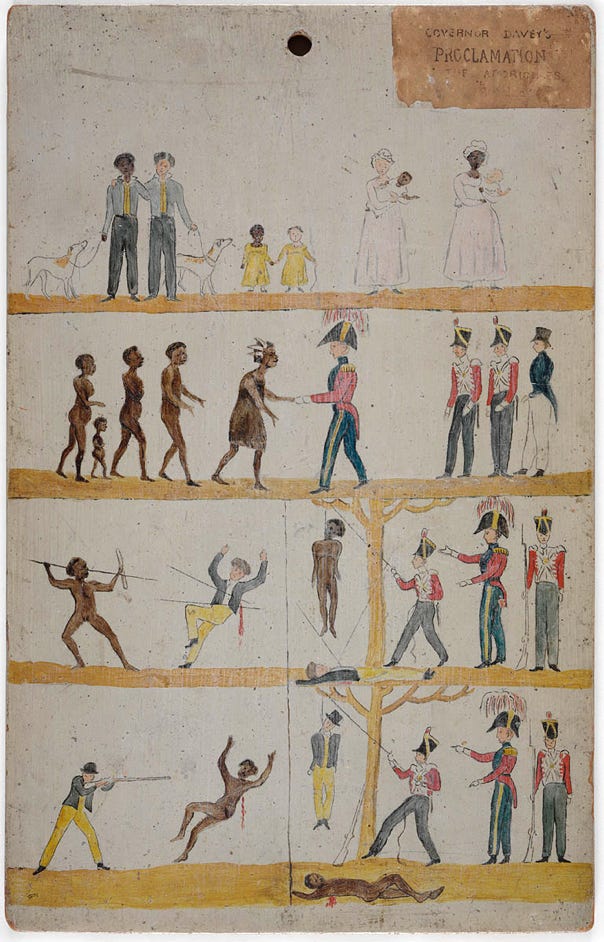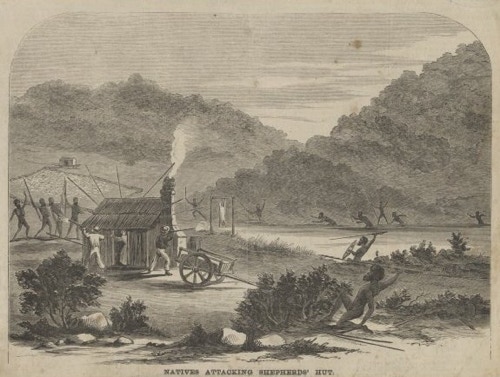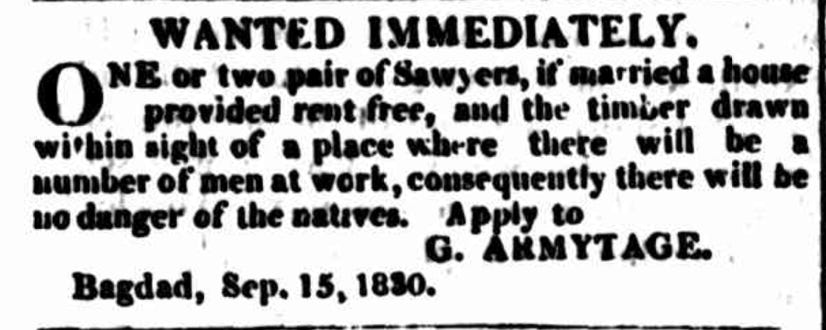Part B.
1830 Tasmania: The Black Line.
Van Diemen’s Land 1830
...”Nearly one million sheep had been moved into prime grazing land that was also the native habitat of Aboriginal food sources like kangaroos and other native animals. The sheep destroyed local ecosystems and disrupted food and water sources.
In about 1824, the ‘Black War’ began. The most extensive conflict in Australian history, the Black War was extremely violent. Settlers drove Tasmanian Aborigines from their lands, murdering many. Tasmanian Aborigines also attacked and killed settlers and their families, raiding houses and farms for food and resources, and trying to drive out the British.
Most of the frontier conflict was concentrated on the traditional lands of four nations – the Oyster Bay, Big River, North Midlands and Ben Lomond peoples. The land in this region was extremely productive and was quickly occupied by European settlers.
http://www.nma.gov.au/online_features/defining_moments/featured/the-black-line
…”There were many massacres of both Indigenous and non-Indigenous people, the majority of which were never recorded in writing, although oral histories were passed down. One massacre reported by George Robinson (1791–1866), the future Chief Protector of Aborigines in the Port Phillip District, is known as the Cape Grim massacre. In February 1828, four shepherds killed 30 Pennemukeer people. In response, Governor Arthur banned Aboriginal people from entering the settled districts of Van Diemen's Land. He claimed that this would prevent conflict between the two groups. The following November [1828], Governor Arthur declared martial law against Aboriginal people , authorising the killing of Aboriginal people on sight. Although Tasmanian Aboriginal groups fought back it is believed that more than 60 per cent of the total Aboriginal population of Tasmania was killed in the 12 months after martial law was declared. Of the remaining Aboriginal population, many were moved into camps that have been compared to concentration camps, where conditions were so horrific that many did not survive.” https://www.myplace.edu.au/decades_timeline/1820/decade_landing_18.html?tabRank=2&subTabRank=4
…”By winter 1829 the southern part of the Settled Districts had become a war zone and Aboriginal people later identified campsites where their relatives had been killed and mutilated. Several more incidents were reported in which Aboriginal people were raiding huts for food and blankets or digging up potatoes, but they too were killed. In an effort to conciliate Aboriginal people, Arthur arranged for the distribution of "proclamation boards" comprising four panels that depicted white and black Tasmanians dwelling together peaceably, and also illustrated the legal consequences for members of either race that committed acts of violence—that an Aboriginal would be hanged for killing a white settler and a settler would be hanged for killing an Aboriginal person. No colonist was ever charged in Van Diemen's Land, or committed for trial, for assaulting or killing an Aboriginal person. “ https://en.wikipedia.org/wiki/Black_War
…”Vigilante gangs of soldiers and settlers avenged Aboriginal attacks by killng men, women and children. In 1830 [on 7th Oct.] a military operation known as the 'Black Line' was launched against the Aboriginal people remaining in the settled districts. Every able-bodied male colonist convict or free, was to form a human chain across the settled districts, moving for three weeks south and east in a pincer movement, until the people were cornered on the Tasman Peninsula.” http://www.indigenousaustralia.info/land/invasion/tasmanian-land-war.html

The Hobart Town Courier (Tas. : 1827 - 1839) Sat 25 Sep 1830 Page 1
GOVERNMENT ORDER. [re The Black Line] TROVE - National Library of Australia

Governor Arthur’s Proclamation to the Aboriginal People
State Library of New South Wales
via Wikimedia Commons

The Hobart Town Courier Sat 25 Sep 1830 Page 4
GOVERNMENT ORDER. [re The Black Line]
TROVE - National Library of Australia

'Natives attacking sheperds' hut'. Samuel Calvert (1828-1913)
National Library of Australia picture nla.pic-an8957159 via Wikimedia Commons

The Hobart Town Courier (Tas. : 1827 - 1839) Sat 25 Sep 1830 Page 1
TROVE - National Library of Australia
Research - Part B
29. RESEARCH Part B - A story of Thomas and Ann Peters.
30. RESEARCH Part B - Thomas Peters is transported for the term of his natural life
31. RESEARCH Part B - Mary Ann Peters accompanied her convict husband
32. RESEARCH Part B - 1803 Thomas, Mary Ann, & Elizabeth (2yrs) came to Port Phillip aboard the Calcutta
33. RESEARCH Part B - 1804 Peters family transferred to Van Diemen’s Land & Martha is born
34. RESEARCH Part B - 1805 Hobart Town: Mary Peters receives a Land Grant on New Town Rivulet
35. RESEARCH Part B - 1806 & 1807 The Peters have a farm with 4 cattle 2 sheep & a goat.
36. RESEARCH Part B - 1808 - 1812 Hobart Town: Martha dies, Thomas is pardoned, & 3 babies are born.
37. RESEARCH Part B - 1814 Hobart Town: Property deals, Horse races & a baby.
38. RESEARCH Part B - 1815 - 1816 Hobart Town: A juror, a boat race, supplying wheat & meat + 8th child
39. RESEARCH Part B - 1817 Hobart Town & York Plains: Thomas Peters receives a Land Grant
40. RESEARCH Part B - 1817 Hobart Town & Bagdad: the Duke of York & Baker’s farm
41. RESEARCH Part B - 1817 Hobart Town,York Plains, Bagdad & Tarrets’s farm
42. RESEARCH Part B - 1817 Hobart Town & Bagdad: Education, an executor, & stock moved from Herdsman’s Cove.
43. RESEARCH Part B - 1818 Hobart: A heavy cart and a ferry accident
44. RESEARCH Part B - 1818 Hobart: A court case, a house for sale. & Elizabeth marries George Armytage
45. RESEARCH Part B - 1818 Hobart: Stock on Birch’s land + Kickerterpoller & the Friendly Missions
46. RESEARCH Part B - 1819 Hobart: Rents to Supreme court & Mary Ann Peters (nee Hews) dies aged 39
47. RESEARCH Part B - 1819 - 1821 Hobart: Found guilty of ‘contumacious conduct in court’.
48. RESEARCH Part B - 1824 - 1829 Bagdad: Louisa marries John Hayes & Charlotte marries Francis Flexmore
49. RESEARCH Part B - 1830 Tasmania: The Black Line.
50. RESEARCH Part B - Nov 1930 Many Aborigines slip through the Black Line and the Peters house is raided.
51. RESEARCH Part B - 1830 Bagdad: As the Black Line advances settlers houses are attacked
52. RESEARCH Part B - 1830 Bagdad: Sophia Peters (16) and Ann Peters (14) are speared & Ann dies of her wounds.
53. RESEARCH Part B - 1830 - Following the Tasmania Wars the surviving traditional owners are rounded up
54. RESEARCH Part B - 1831 - 1839 Bagdad: Mary Ann Peters & Sophia Matilda Peters both got married,
55. RESEARCH Part B - 1839 Bagdad Thomas Peters dies
56. RESEARCH Part B - The 8 Children and 48 Grandchildren of Thomas & Mary Ann Peters
57. RESEARCH Part B - A Story of Thomas Peters and ‘the Brady Gang’
58. RESEARCH Part B - Where to next? Choices, choices, choices.

